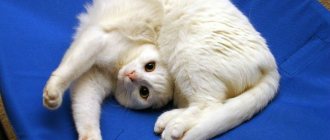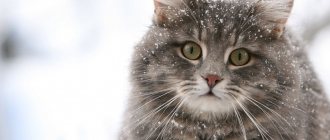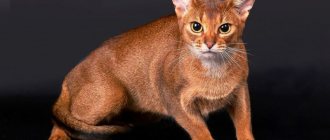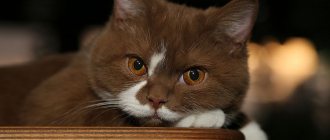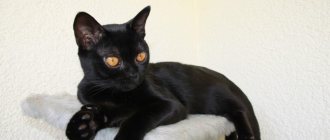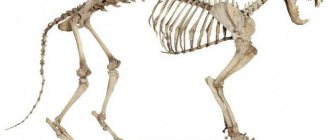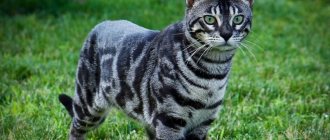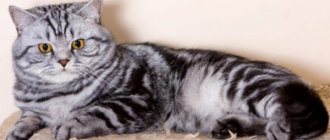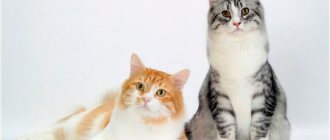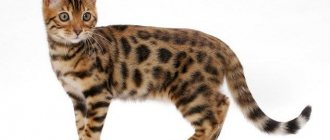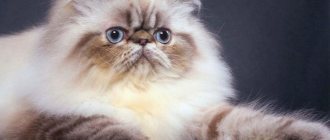The tabby color in cats does not indicate that the pet belongs to a specific breed. This coat color is considered one of the most ancient and beautiful varieties. A large number of breeds have a striped pattern, which is a hereditary trait. Among tabby cats, there are very rare and unusual individuals that attract attention with an intricate combination of stripes and curls.
Features of tabby color
The intricately spotted colors of a cat's fur are considered the most natural. Therefore, it is the most common compared to other colors.
What does it look like
The English word tabby is translated as “motley” or “striped.” A peculiar natural coloring is observed in babies almost from birth, and with age it acquires a finished appearance. Despite the large combination of various patterns, all animals have features that unite them:
- a mark in the shape of the letter M in the forehead area;
- bright edging around the nose and eyes;
- ornament in the form of a necklace and “bracelets” on the tail and paws.
The irises of cats and tabby cats come in mostly warm shades: yellow, light brown or copper. Only some representatives with silver shades have green eyes.
Origins and genetics
The tabby color in cats appeared due to the peculiarities of genetics. Here the influence of gene “A” (agouti), which belongs to the group of superdominant ones, is manifested. It is he who has the ability to color the hairs on the animal’s body in a special way - with alternating different tones.
Dark areas are more clearly defined due to the large amount of eumelanin (dark pigment). In the light parts of the coat there is much less of this pigment, which gives the effect of alternation and contrast, which is so attractive with its beauty and originality.
All fluffies initially have a tabby color according to their genotype. This is evidenced by the residual “baby” tabby in kittens, which disappears after the first molt - the babies acquire the colors characteristic of their breed.
Scientific research has proven that the stripes and spots on the body of domestic whiskers are similar to the appearance of African, Asian and European wild cats. Accordingly, there are five genetically related clusters in different parts of the world.
An interesting version of the origin of the name itself. According to legend, the name of the color was given in honor of the Attabiya district in Baghdad. Amazingly beautiful fabrics with unusual patterns were supplied to England from this place in the 17th-18th centuries. A fan of whiskers thought that the stripes on the cat's body were very similar to bizarre stains on fabric.
Breeders tend to classify all medieval mustaches as this type. Indeed, a large number of engravings and illustrations of that time show striped individuals. From the end of the 17th century, the term tabby cat began to be used to refer to all tabby-spotted individuals. After some time the second word was omitted.
What determines the color of a cat?
All cat breeds that exist today are descended from several species of wild cats that lived in the hot African savannas or the snowy forests of Europe. Initially, color served a very practical role - it made the animal “invisible” among thickets of bushes or tree branches, so wild cats were predominantly spotted or striped gray, brownish, sandy in color. After domestication through selection, new shades began to appear in the color of cats.
What explains the variety of shades and patterns on pets' fur coats? The color of the coat is due to the presence of the high molecular weight pigment melanin in the hair body. There are 2 varieties of it: eumelanin, which absorbs the visible part of the spectrum, and we see hair as black, chocolate, gray, blue, and pheomelanin, which reflects the red-orange-yellow part of the spectrum and gives a red or cream color.
The presence of one or another pigment is determined genetically. The O gene is responsible for the activation of pheomelanin, and the o gene is responsible for the activation of eumelanin. Both of them are located on chromosome X, that is, the inheritance of color is linked to sex.
Cats have 3 color options: OO (dark), OO (red), OO (tri-color). Since cats only have one X chromosome, they should not normally be tortoiseshell. Nevertheless, such males do occur, but, as a rule, they turn out to be sterile and unable to reproduce.
Types of tabby colors by pattern
Based on numerous photos on the Internet, it can be seen that tabby colors in cats are varied. There are several generally accepted patterns that vary genetically. These types are: classic, ticked, spotted and striped. The remaining species are presented as a mixture of tabby color with other types.
All of these variations were identified in populations during random breeding. Some unusual patterns of this type are noticeable in different breeds. For example, a modified type of the classic species is observed among representatives of the Sokoke species. Presumably this is due to the combination of wild and domestic genotypes. Rosette and marble patterns are characteristic of Bengals.
Classic (marble)
This type of tabby cat is considered one of the most traditional and beautiful. The ornament in the form of spiral or graphic patterns is located throughout the pet’s body. The patterns on the back and sides of the animal are clearly presented; on the legs and neck they have faint outlines.
The body of the marbled tabby is covered with large spots and curls that resemble human eyes, butterfly wings, and a snail. The shade of the patterns is very different from the main tone of the coat. Representatives of the cat family with this color are characterized by any colors - with the exception of white.
Striped (mackerel)
The variation, which is characterized by clear narrow stripes located throughout the body, has several names: mackerel, brindle or striped tabby. The latter name is associated with the mackerel fish, which also has stripes all over its body.
The pattern on the skin of mackerel tabby cats is clearly marked and starts from the ridge line. Descending towards the abdominal area, the stripes branch out. The tone of the pattern differs greatly from the main background of the hairline. An M-shaped mark on the forehead appears along with dark stripes at the corners of the eyes and on the cheeks of the animal.
Spotted
Stripes on the body of spotted individuals are completely excluded. The pattern is presented in the form of intermittent dots or spots with jagged edges. The color scheme of the patterns may differ slightly or strongly contrast compared to the main background. Individuals with spotted tabby coloration are very similar to miniature wild cats.
This species is a modification of the mackerel species, in which the stripes are divided into spots. Notable examples are the Maine Coon, Ocicat, Egyptian and Arabian Mau, Bengal, Australian Mist, Serengeti, and Savannah breeds.
Ticked
The ticked tabby color in cats is considered one of the most refined and inconspicuous. Initially, it seems that the coat has a uniform color. But, if you look closely, a pronounced ornament on the muzzle, paws, and tail becomes noticeable. A closer examination of the pet allows you to notice faint stripes and spots throughout the body. They differ from the main background by only a few tones. This type is found in Abyssinian cats.
Rosette or leopard print
This type is a rare variant. It is characterized by large spots located throughout the body of the animal. The circles have a dark edge, resembling an uneven circle, and a pale center. The main color of the hair and the color of the markings are different. On the pet's head, neck and paws the pattern is presented in the form of dark stripes.
Tortoiseshell
This type is rare. Its main feature is the presence of two primary colors - most often black and yellow. The pattern of individuals with a tortoiseshell pattern is not clear and graphic. It does not have a precise order and is not clearly expressed against the general background.
Calico
The uniqueness of this color is its three-color base. Usually the animal's paws, chest, tail and muzzle are white. The pattern on the back and head resembles short lines and large spots. Breeders gave another name to this type - spotted with white.
Tabby point
Tabby point cats look very interesting. The main spotting of the pet is concentrated in the area around the eyes. The forelimbs have a pattern in the form of torn rings. The hind legs of the fluffy are monochromatic. Distinct stripes stand out on the hips. The fur on the ears is the same tone. It is mandatory to have a light mark on the outer part of the auricle.
Golden tabby colors of Kurilian Bobtails with white
Golden merle bicolor colors of Kurilian bobtails
| Black gold marble bicolor | Black tortoiseshell golden marbled bicolor NO PHOTO |
| Blue gold marble bicolor NO PHOTO | Blue tortoiseshell gold marbled bicolor NO PHOTO |
Golden marbled harlequins colors of Kurilian bobtails
| Black Gold Marble Harlequin NO PHOTO | Black Tortoiseshell Gold Marble Harlequin NO PHOTO |
| Blue Gold Marble Harlequin NO PHOTO | Blue Tortoiseshell Gold Marble Harlequin NO PHOTO |
Golden marbled with white spots colors of Kurilian Bobtails
| Black gold marbled with white spots | Black tortoiseshell golden harlequin with white spots NO PHOTO |
| Blue golden marbled with white spots | Blue tortoiseshell gold marbled with white spots NO PHOTO |
Color variations
Among the representatives of the tabby cat family, silver individuals predominate. There are also gray tabbies with patterns of different shades. This could be a purple, chocolate, blue, smoky and reddish palette.
Such colors often depend on the ornament presented on the body. For example, the classic or marble version combines different dark lines and a pale tone of the fur coat.
When varying with spots, a pattern in a warm palette predominates. Mackerel or striped combines dark stains on a silver or gray cover. With the ticked version, almost the entire palette of colors that is possible in the cat world is observed. Here are the most popular varieties:
- Smoky type
– the pattern resembles the coat of a wild lynx combined with the black color of a tabby.
- Silver tabby
- a drawing of a darker tone on a white background.
- Blue tabby
– gray and blue patterns stand out on pale fur.
- Brown tabby
- black and smoky ornament located on a red-brown background.
- Black silver tabby
– the smoky pattern is on gray wool.
- Sil-type
– pale brown dots are visible on the cream-colored coat, paws, ears, tail and muzzle are striped.
- Lilac tabby
– purple pattern on light beige hair.
- Red tabby
– a reddish ornament stands out on the peach cover.
- Cream tabby
– cream patterns are located on the coat several shades paler.
The listed options are the most popular among cats. However, many years of selective research by breeders have made it possible to create a large number of color combinations characteristic of certain breed representatives.
What does marble color look like?
Marble pattern is characterized by a certain arrangement of dark lines on a light background. On the muzzle it appears in the form of a “scarab” on the forehead and expressive arrows from the outer corner of the eyes. The nose and eyes are outlined with eyeliner to match the base color, which is considered dark. The colored stripes around the neck form a “necklace”; three wide lines run along the body from the neck to the tail. On the sides, the stripes result in a pattern that resembles butterfly wings or eyes. The tail is decorated with wide rings.
The standard describes only the correct arrangement of stripes, but due to the unlimited number of color variations, marble color is very diverse.
Marble (marbled color in Bengals)
The marbled color of Bengals is called marble and is a modification of the classic tabby. According to the standard, the marks and patterns are the same as those of classic marble, but the stripes may be broken and the rings may not be closed. The drawing consists of three elements: the background, the design and the dark “edge”. The belly is spotted. Marbled kittens are born often, but rarely the pattern is the same as stated in the standard.
Bengal cat color black silver marble (marble)
Special marble colors: “on gold” and “on silver”
Marble colors look even more beautiful and impressive if breeders pay attention not only to improving the pattern, but also to the background shade. For example, if a British marbled cat manages to change the color of its undercoat from yellow-brown to golden sand, it is called “marble on gold.” When the beige tone of the undercoat, for example, in the Scottish Fold, changes to white, they say “marble on silver.” Even in the photo, golden and silver cats immediately stand out from among the “ordinary” merle colors.
It has been noticed that in breed lines where there is excellent “gold”, there are many rufisms on silver animals and vice versa.
Regarding the pattern, the requirements remain the same, but the undercoat, which forms the background, must be sunny golden or pure white. The appearance of yellowness (usually on the nose, whiskers, chest or paws) is called rufism. In golden and silver cats, the desired eye color is green. But it can also be orange - pewter.
British cat (black marble on silver)
Scottish fold pewter cat (black marble on gold)
Tortoiseshell marbled color
Marble turtles look very interesting. Externally, the color appears in a marble pattern on a two-color background. In the world of phenology, this color is called torbie (from the English tabby + tortie = torbie).
Scottish straight cat, tortoiseshell marbled color
Tabby Color Standards
It doesn’t matter what type the fluffy one belongs to - the animals are still characterized by some features that unite them. First of all, this is the presence of a spiral or graphic pattern. It is created by two types of hairs, forming a ticking. Some hairs are not completely colored and serve as the basis, while others are painted entirely in the main tone of the pattern.
Cats are also distinguished by an original pattern on their forehead, which resembles the letter M. On the outside of the ears, furry animals have light oval-shaped dots. The eyes and nose are outlined by stripes of a basic tone.
Fine lines are clearly visible on the muzzle. They are less noticeable in silver or golden individuals. The eyelids and chin are a little paler, and in the cheek area you can see elegant patterns in the form of spirals. The lips and pads of the hind and forelimbs are highly pigmented.
The chest is decorated with stripes, shaped like a necklace or choker. The same patterns, in a smaller version, are found on the front and hind legs, as well as the tail.
On the stomach of cats there are double spots placed in two lines. The pattern is drawn clearly, so it looks contrasting. In photos of pets, it is noticeable that the silver tabby often has a bright green iris, while other types are golden-yellow or copper-orange.
The complexities of merle colors
Breeders who breed marbled cats of British, Scottish, Bengal and other breeds face various problems in their work, due to which the color cannot fully comply with the standard.
- Expressiveness - too bright a contrast between the picture and the background;
- Shading - discolored, as if erased, marble;
- Large width of elements through which the light background is barely visible;
- Excessive ticking - externally manifests itself in a blurred pattern;
- Torn pattern - stripes can simply break or even turn into spots;
British cat (black marbled color)
Cat breeds with this color
There are a large number of tabby cats. They can be seen among the most elite breeds and among domestic representatives. All pets have an interesting pattern and markings on their foreheads.
The most popular tabby cat breed among breeders is the British breed. People are attracted by its unusual appearance, which is the result of many years of selection and successful crossing experiments. There are a number of variations of the breed, in which there are types of mackerel, classic, ticked, spotted. The British are characterized by symmetrical spots with clear lines and contrasting patterns.
Other popular representatives are Scottish individuals. Their main features are the presence of a contrasting M mark, a rim around the nose and eyes, as well as rings on the paws and tail. The most common are marbled representatives, but Scots are also brindle and spotted.
Another famous breed with an unusual appearance is the Maine Coon. It is characterized by a smoky or brown variation and a variety of types - from classic to leopard. Maine Coons are not only ticked. The long hair of individuals can be dyed completely or only at the tips.
Other breeds with tabby color:
- Siberians;
- pixie bob;
- Bengals;
- Ceylonese representatives;
- Persians;
- safari;
- toyger;
- sokoke;
- Egyptian Mau;
- leohouse;
- savannah.
The only breed whose representatives have their type reflected in their name is the Asian tabby. These short-haired individuals were bred in England at the end of the last century. Asians are friendly and inquisitive. They come in four main pattern types: classic, striped, spotted and ticked. Sometimes tortoiseshells are also found.
Domestic mustaches that have not acquired a pedigree may also have patterns on their bodies corresponding to their type. Sometimes outbred individuals have a surprisingly wide color palette. Such combinations, invented by nature itself, will definitely not be obtained as a result of breeding work.
Features of breeding marbled cats
Typically, merle kittens are obtained from the mating of two merle cats. Since the color is recessive, such mating provides a guarantee of getting marbled in the litter. Also, merle kittens are obtained if one of the parents is spotted and the other is brindle, but both of them are carriers of the recessive merle gene. Marble can be born from a pair of brindle cats, as well as spotted ones, but again, provided that both parents are marble carriers.
Red tabby kitten
In which breeds is the tabby pattern considered a defect?
Among the variety of cats, there are breeds for which the presence of an ornament of stripes or spots is unacceptable. The appearance of such marks will be considered a deviation from the standards, and the individual will be discarded during selection or breeding.
Among the breeds without tabby patterns inherent in the type, you can see very popular species: Russian Blue, Burmese, Havana Brown, Bombay, Chartreuse, Korat. The coat of these representatives has colors and patterns specific to their breed - usually monochromatic or a combination of both.
As a result of the domestication of wild individuals and successful breeding work, many representatives of cats appeared with various stripes and spots on the body. Such animals are the most common and popular all over the world.
Rare colors
Experiments to obtain new Thai colors continue. Among the original shade combinations:
- cinnamon point, where the ivory body is covered with warm cinnamon tone markings;
- Caramel Point with a magnolia-white coat and brownish-gray markings;
- Fawn Point with a coat resembling a white magnolia shaded with a light lilac-pink or beige color and markings of a warm pale pink tone;
- gray-brown point with almost white coat without shading. The tone of the markings is cold, the color is brownish-gray, giving off a pinkish tint.
There are also tabby, torty and torty-tabby varieties of these colors. Silver point and apricot point cats are not yet recognized. But English and Dutch breeders are working hard in this direction. The line between them and already known colors is so thin that only professionals can catch it. Such combinations of colors on Thai wool are still rare and appear as a result of spontaneous mutation.
Cat lovers traditionally prefer the seal point color. But it is almost never represented at exhibitions. There are most tabby points there. A few chocolate points and blue points provide pleasant variety. It is very rare to see red-point and tortoiseshell cats.
